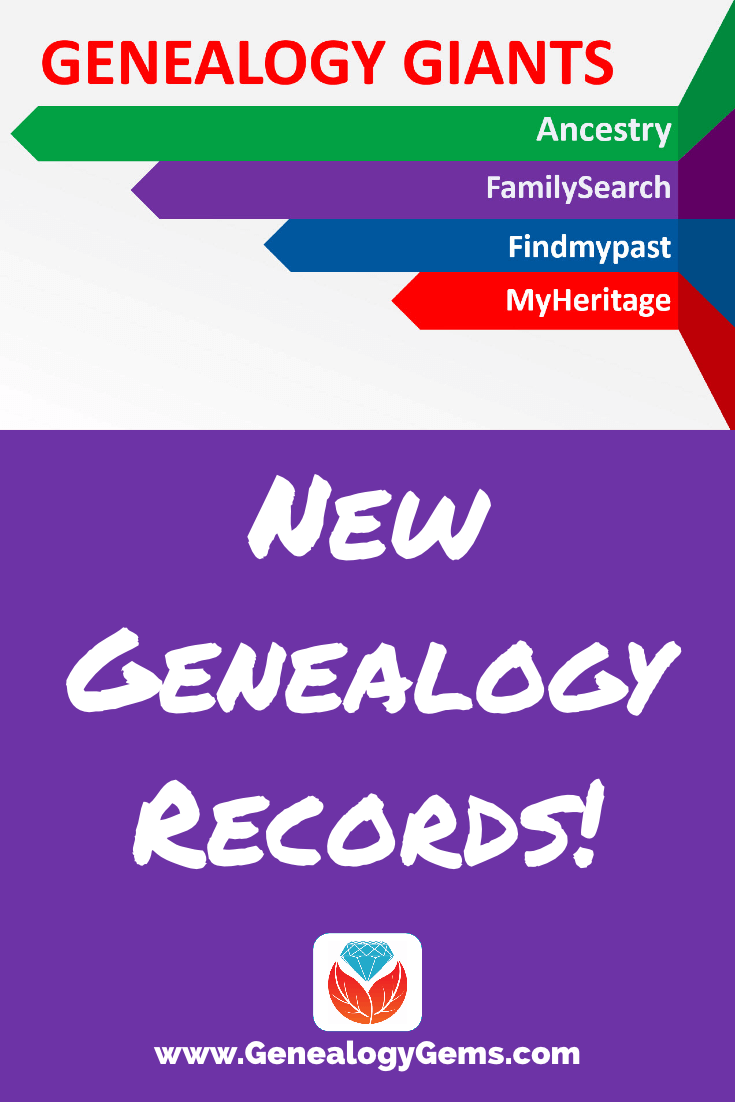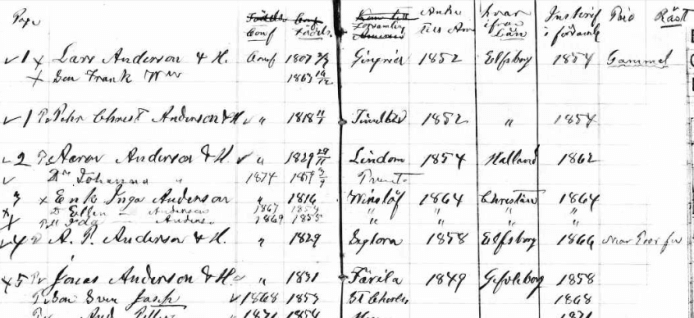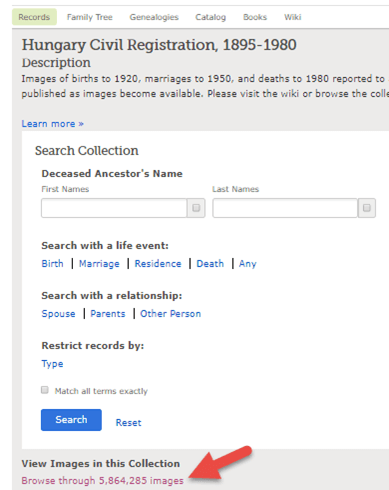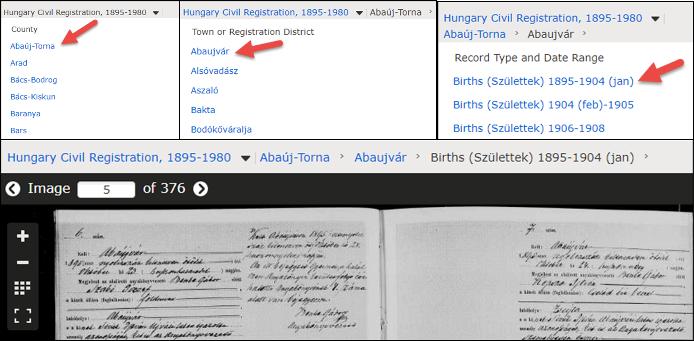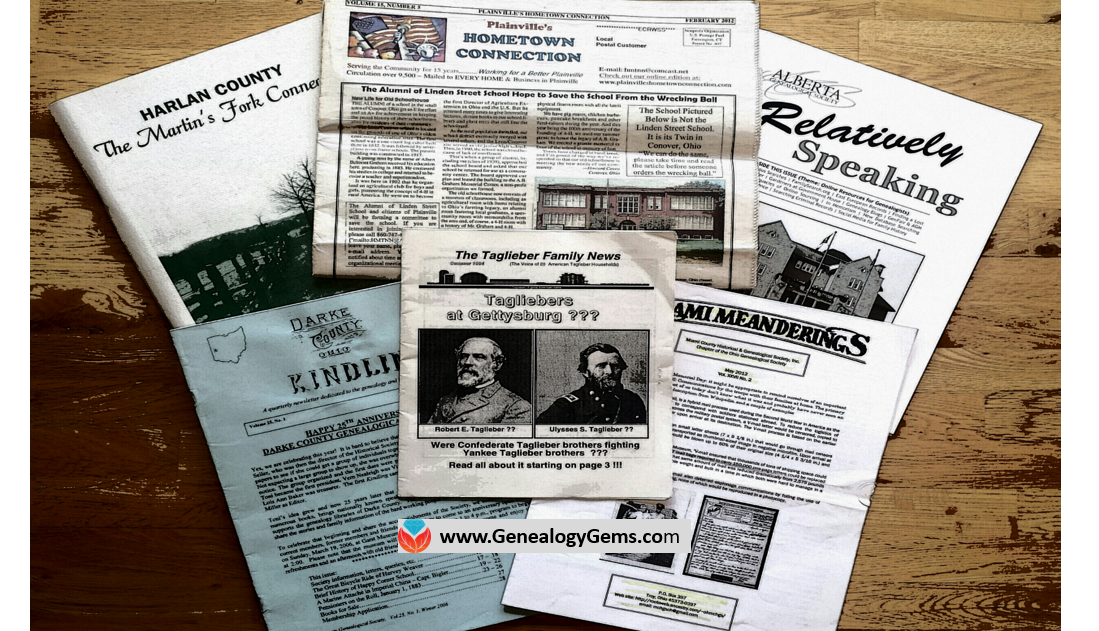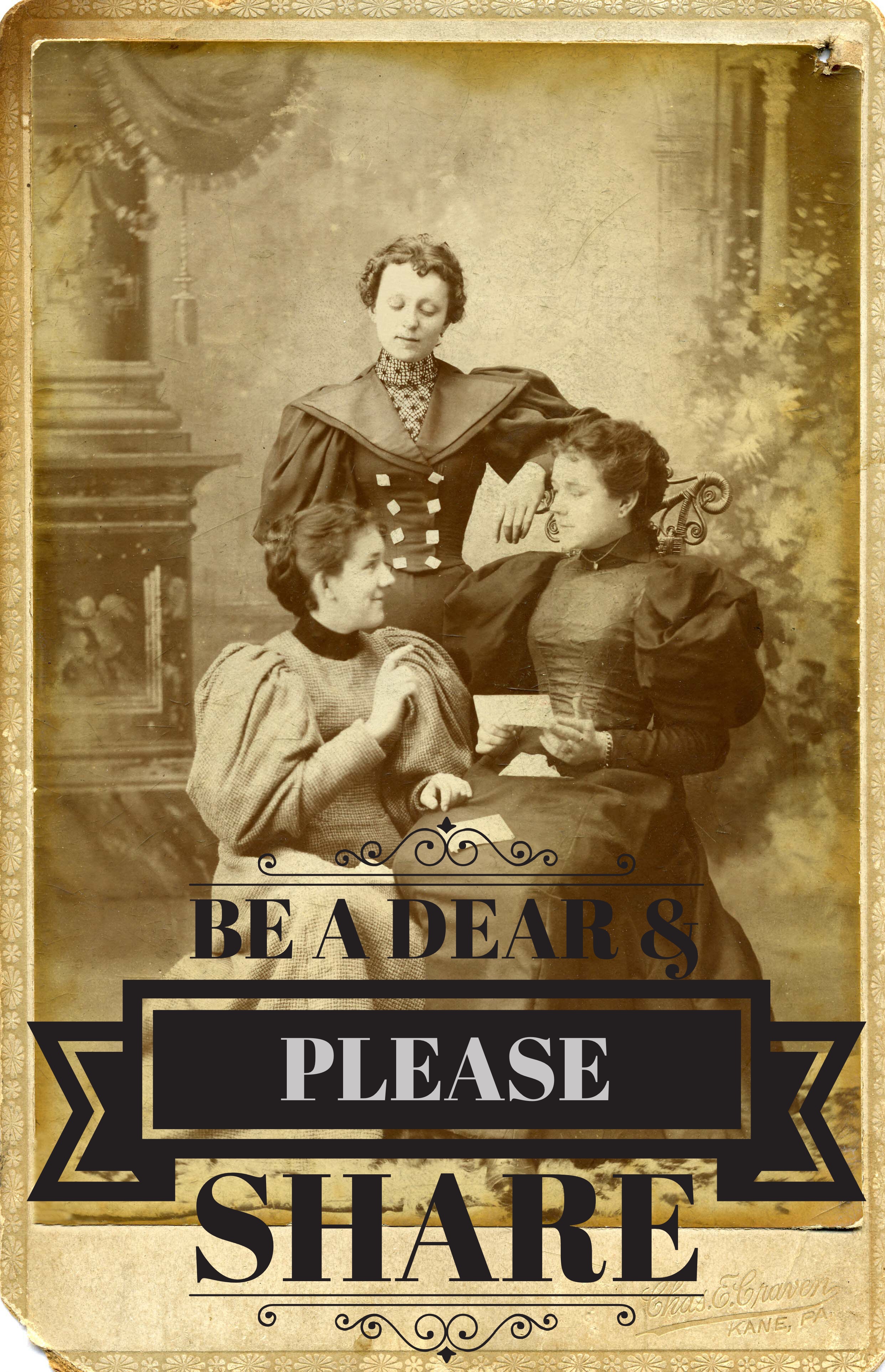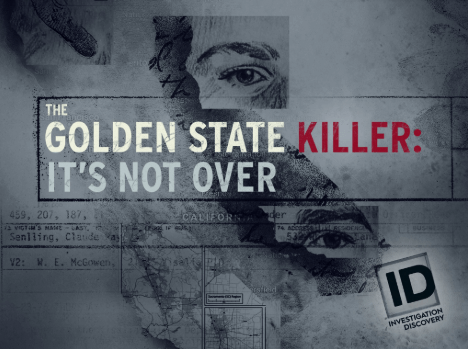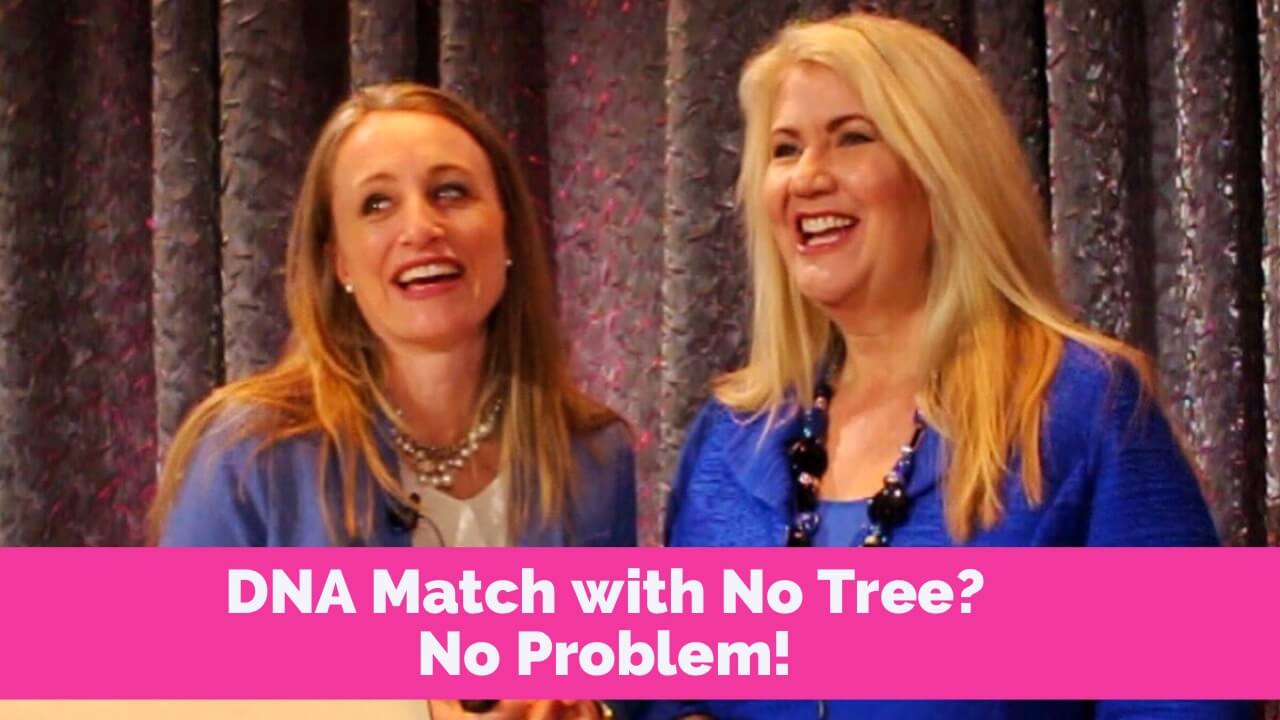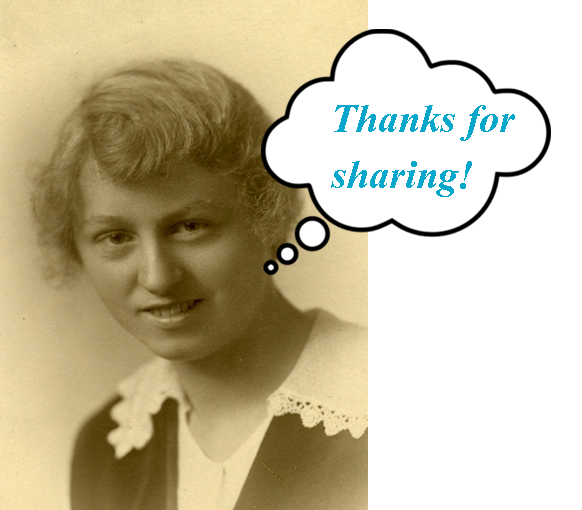Blog

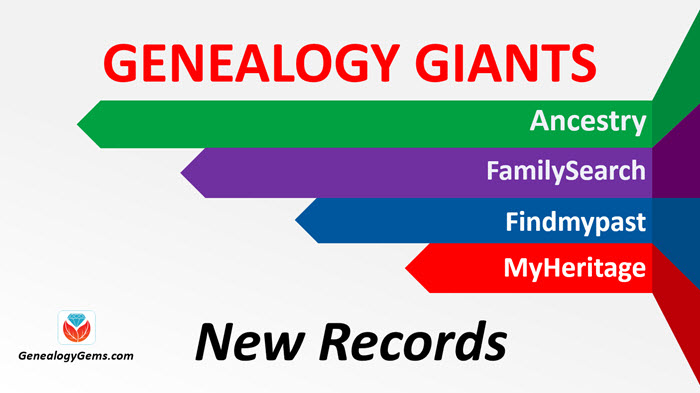
New Records on Ancestry.com, FamilySearch and Findmypast
Search millions of new records on Ancestry.com, FamilySearch & Findmypast, three of the Genealogy Giants. Find your family history in Australia, Brazil, Canada, Denmark, England, Germany, Hungary, New Zealand, Panama, Poland, Sweden, the U.S., Wales and in PERSI, the Periodical Source Index.
Welcome to Genealogy Gems’ weekly roundup of new and updated genealogy records! Browse the lists below to see what’s become available recently at three of the Genealogy Giants, Ancestry.com, FamilySearch.org & Findmypast.com.
New records on Ancestry.com
Australia. About 7 million records total appear in Ancestry.com’s new Australian vital records indexes, Victoria, Australia, Marriage Index, 1837-1950 and Victoria, Australia, Death Index, 1836-1988. According to their collection descriptions, these records come from The Victorian Registry of Births, Deaths, and Marriages, Melbourne, Victoria, Australia.
England and Wales. The 1939 England and Wales Register is now on Ancestry.com! With nearly 46 million records, it’s a de facto national census conducted just before World War II. (The 1939 Register is also searchable at Findmypast.com and MyHeritage.com.)
Poland. In partnership with the U.S. Holocaust Memorial Museum, Ancestry.com has published Poland, Modliborzyce Ghetto Register Books, 1939-1944. These records are part of the USHMM’s collections and are described by them as “Documents of the Jewish Council in Modliborzyce (administrative district of Janów Lubelski), including alphabetical name list for January through September 1942.”
New Zealand. More than 350,000 records appear in the new Ancestry.com collection, New Zealand, World War I Service Records, 1914-1920. According to the collection description, “This database contains New Zealand Defense Force (NZDF) Personnel Files for all known New Zealanders who served in the First World War. The records contain information of interested to personal and professional researchers alike, including: transfers, promotions, punishments, medals and honors received, health status and medical history and other biological information. Military service files typically include several documents. The primary document which has been indexed and is searchable by name is the Attestation Sheet. The attestation sheet includes personal information about the individual who served….Additional documentation may be found in the files, including correspondence.”
North America. An even larger collection of church records relating to Swedes, or at least, Swedish emigrants, is Ancestry.com’s U.S., Evangelical Lutheran Church in America, Swedish American Church Records, 1800-1946. Here’s a sample image:
This collection boasts 3.5 million records from the Swenson Swedish Immigration Research Center at Augstana College in Rock Island, Illinois. From the collection description: “The records in this collection consist of administrative records from select affiliates of the Evangelical Lutheran Church in America. There are also select records from Canada. Indexes have been provided for baptisms, marriages, burials, and membership records (arrivals, dismissals, and member lists), as well as congregational histories and biographical files of church leaders. The member lists, in particular, have a wealth of information, including vital dates and emigration information. Some member lists may include the location in Sweden an individual or family was originally from. Records are written in either English or Swedish.”
Sweden. Close to 2 million indexed records appear in a new series of Swedish church record databases on Ancestry.com:
- Uppsala, Sweden Church Records,1613-1860;
- Kalmar, Sweden, Church Records, 1625-1860;
- Södermanland, Sweden, Church Records, 1640-1860
- Västernorrland, Sweden, Church Records, 1650-1860
- Jönköping, Sweden, Church Records, 1633-1860
- Sweden, Örebro Church Records, 1613-1918; index 1635-1860
The indexes come from the free Genealogy Giant FamilySearch.org, where you may also find record images pertaining to these records.
United States, New York. Over a million records appear in the new collection, New York State, Death Index, 1957-1968. FYI, this database is also available to search on the New York state government website for free, but I find it much easier to search at Ancestry.com (and Ancestry’s powerful and flexible search technologies may help you find people’s names who may appear differently than you expect).
New records on FamilySearch.org
Brazil. Nearly 140,000 indexed names have been added to an existing collection on FamilySearch.org, the always-free Genealogy Giant: Brazil, Rio de Janeiro, Civil Registration, 1829-2012. Among the records are “births, marriages, deaths and indexes created by various civil registration offices in the state of Rio de Janeiro.” This collection is partially-indexed: browse the records to see what’s available for your ancestor’s locale. (See below for instructions on how to do this.)
Denmark. About 12,000 indexed names have been added to Denmark, Copenhagen City, Civil Marriages, 1739-1964, Index 1877-1964. According to the site, the collection includes “marriage licenses and records for the city of Copenhagen for the years 1739 to 1964.” However, the detailed collection description in the FamilySearch wiki includes some conflicting information about the dates covered. Go ahead and search anyway—and follow the wiki tips for getting the most out of the collection.
Germany. Over 1.1 million indexed records have been added to Germany, Bavaria, Diocese of Augsburg, Catholic Church Records, 1615-1939. Among the records are baptisms, marriages and burial records from the diocesan archive. Accessibility alert: a notice on the collection description page states that “These images are available to view at Family History Centers. If possible, visit your nearest Family History Center to view the images.” Click here to learn about image access restrictions on FamilySearch.org and click here to find a Family History Center near you (they’re free to use, but most have restricted hours).
Hungary. Nearly 60,000 indexed records have been added to the free collection, Hungary Civil Registration, 1895-1980. These are “images of births to 1920, marriages to 1950, and deaths to 1980 reported to and recorded by civil registrars. Coverage varies by locality. This collection is being published as images become available.”
Check current coverage by browsing the collection (from the bottom of the collection page, as shown here). As shown below, you can browse which regions have available records. Click a region to see which locales have records, and then click a locale to see which specific records are available. Click on individual record sets to page through them in your browser.
Panama. Nearly 150,000 indexed records have been added to Panama, Catholic Church Records, 1707-1973. Among these are “baptisms, confirmations, parish censuses, marriages, pre-marriage investigations, marriage dispensations, deaths, and indexes” created by parishes and dioceses. Again, use the browsing technique shown above to see what records are available for your ancestor’s locale.
New records on Findmypast
Featured global collection: The PERiodical Source Index of all known genealogical and historical periodicals (with especially strong coverage of the U.S.) has added over 10,000 new articles to its subject index (along with 35,148 new digital images of some of those articles). The publications indexed here include historical, genealogical and ethnic newsletters, journals, magazines and other kinds of periodicals.
Individual articles often include biographies, historical sketches, maps and transcripts of cemetery, census, church, court, land/property, institutional, military, naturalization, obituary, passenger, probate, school, tax, vital, voter and will records. You don’t need to have a subscription at Findmypast.com to search the index (and when you see interesting search results you can’t access in full, you have the option to purchase Pay-As-You-Go credits or sign up for a free trial).
Australia. Queensland, Justices of The Peace 1857-1957, with nearly 30,000 records from the Queensland State Archives, lists names of Justices of the Peace, along with oath year and number and archival reference information. Also for the same region, Queensland, Register of Land Sold 1842-1859, includes over 7,100 records of land transactions during Queensland’s colonization era, along with names, locations and property details.
England & Wales. Over 146,400 new images have recently been added to this Genealogy Giant’s unique and extensive Catholic Heritage Archive. Dating to 1575, the collection includes a range of Catholic Record Society publications and a list of Roman Catholics from York in 1604.
England. Findmypast has added parish records for the following locations (and according to the site, the Staffordshire and Shropshire online collections are exclusive to Findmypast):
- Staffordshire Registers & Records. Over 119,500 images of 23 distinct publications of parish registers (which include baptisms, marriages and burials).
- Lancashire Registers & Records. Over 171,000 images of parish registers, court rolls and local histories.
- Shropshire Registers & Records. Over 23,000 images from an eclectic collection of publications date back to the 14th century.
- Surrey Baptisms. Over 476,000 records! Explore transcripts of original parish records for baptisms, birth dates, names and residences of parents and occupations. The collection covers 180 parishes and spans 1538 to 1901. (Findmypast is now home to over two million Surrey records, including baptisms, marriages, monumental inscriptions, court records, probate records and more. Click here to see a list of all collections relating to Surrey.)
North America. Over 800 pages from 12 publications comprise Scots-Irish in North America Histories, a Findmypast collection that covers a variety of date ranges and regions on the Ulster Scots and their descendants in the United States and Canada.
Please help us spread the word!
Every Friday, we share new records on Ancestry.com, FamilySearch.org, Findmypast.com, MyHeritage.com, other websites and digital archives across the internet. We hear from you how these weekly posts help your genealogy. Maybe a specific collection has (finally!) come online. Or maybe you read about an interesting-sounding record type and decide to go searching for something similar for your own family. Will you please help spread the good news by sharing this article on your favorite social media site? And do let us know if any records we mention lead to any discoveries on your family tree. Thanks–you’re a gem!
Disclosure: This article contains affiliate links and Genealogy Gems will be compensated if you make a purchase after clicking on these links (at no additional cost to you). Thank you for supporting Genealogy Gems!

About the Author: Sunny Morton
Sunny is a Contributing Editor at Lisa Louise Cooke’s Genealogy Gems; her voice is often heard on the Genealogy Gems Podcast and Premium Podcasts. She’s known for her expertise on the world’s biggest family history websites (she’s the author of Genealogy Giants: Comparing the 4 Major Websites); writing personal and family histories (she also wrote Story of My Life: A Workbook for Preserving Your Legacy); and sharing her favorite reads for the Genealogy Gems Book Club.
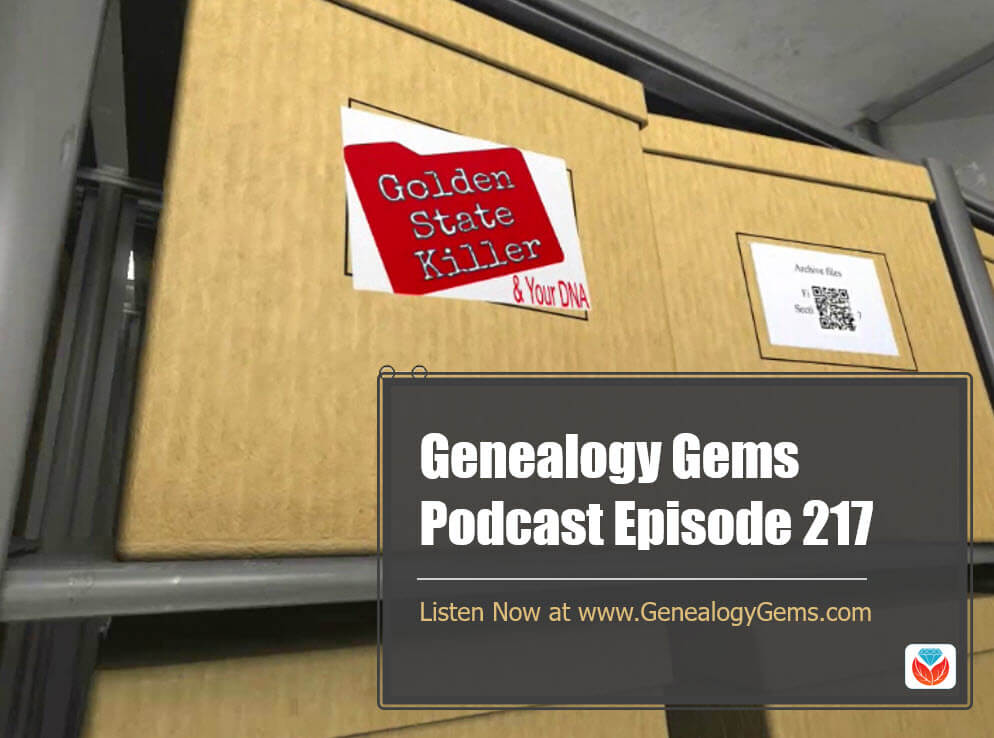
Episode 217 – The Golden State Killer and Your Genealogy and DNA
Genealogy Gems Podcast Episode 217
with Lisa Louise Cooke
In this special episode, host and producer Lisa Louise Cooke takes a look at the Golden State killer, one of the most notorious crime sprees in recent memory. She’ll talk about the role that DNA testing played in an ultimate arrest, and the impact that these events are having on genealogists and the use of DNA in genealogy.
The Golden State Killer
“Golden State Killer: It’s Not Over” docuseries. (As an Amazon Associate, Genealogy Gems earns from qualifying purchases)
“The Golden State Killer,” 48 Hours episode on CBSNews.com (44-minute episode)
Between 1974 and 1986, activities attributed to the Golden State Killer include at least 12 murders, more than 50 rapes, and over 100 burglaries in California from 1974 through 1986.
The criminal’s methods led some investigators to believe that these differently-labeled criminals were very likely one in the same.
In 2001, DNA definitively linked several rapes in Contra Costa County believed to have been part of the East Area Rapist series, a series of murders in Southern California.
In 2011, DNA evidence proved that the Domingo?Sanchez murders were committed by the same man, known as the Golden State Killer.
BONUS CONTENT for Genealogy Gems App Users

If you’re listening through the Genealogy Gems app, don’t forget to check out your bonus content for this episode! The Genealogy Gems app is FREE in Google Play and is only $2.99 for Windows, iPhone and iPad users
MyHeritage.com is the place to make connections with relatives overseas, particularly with those who may still live in your ancestral homeland. Click here to see what MyHeritage can do for you: it’s free to get started.
StoryWorth makes it easy and fun for Mom to share stories with loved ones every week. At the end of the year, she’ll get them all bound in a beautiful hardcover book. Strengthen your bond as you get to know her in a whole new way! Go to http://www.storyworth.com/lisa for $20 off when you subscribe. Give a gift for Mother’s Day that is actually a gift for you, too!
Help solve DNA mysteries with these resources:
- “A DNA Match with No Tree? No Problem!” and “Take Control of Your Family Tree,” Genealogy Gems Premium eLearning video classes
- The Genealogist’s Google Toolbox by Lisa Louise Cooke
- Breaking Down Brick Walls with DNA by Diahan Southard
Caution: In this episode, Lisa shares her personal opinions on the use of technology for crime fighting and the implications for DNA testing for genealogy. She encourages everyone to do their own homework and make informed decisions in line with their own values, opinions, and objectives.
Reality check: “The only way to ensure privacy is to never put anything of any kind online. Just like the only way to ensure you will never be in a car accident is to never, under any circumstances, get in a car.”
Read more about DNA testing company partnerships:
“Another personal genetics company is sharing client data,” Wired.com article by Katie M. Palmer, published 21 July 2015, on Ancestry.com’s partnership with Google-owned Calico biotech firm
“23andMe teams with Big Pharma to find treatments hidden in our DNA,” Wired.com article by Davey Alba, published 12 January 2015, on 23andMe’s partnership with Pfizer
Several ways we already use DNA matches:
- Genealogists use to build family trees
- Adoptees use to identify birth parents (or other biological relatives)
- Orphans trying to find long lost siblings and relatives
- Anyone looking for estranged family members
- Researchers identifying unidentified human remains, including POW/MIAs
Lisa Louise Cooke uses and recommends RootsMagic family history software. From within RootsMagic, you can search historical records on FamilySearch.org, Findmypast.com and MyHeritage.com.
Keep your family history research, photos, tree software files, videos and all other computer files safely backed up with Backblaze, the official cloud-based computer backup system for Lisa Louise Cooke’s Genealogy Gems. Learn more at https://www.backblaze.com/Lisa.
More information on DNA testing
How to download, transfer and upload your DNA with various testing companies by Diahan Southard
“How DIY genetic testing kits can be used against you,” News.com.au article by Gavin Fernando, published 3 May, 2018.

“When you test, you are also making a decision on behalf of your parents, siblings, children, grandchildren, and future descendants. Regardless of good intentions or stated ethics codes in the genealogy community, it isn’t possible to write and get the express permission of everyone who could be affected by you having your DNA tested.” ?Lisa Louise Cooke
Genealogy Gems can help you whether you test or not!
Keep listening to the Genealogy Gems Podcast for genealogy news, tips, inspiration and strategies (DNA is one of many tools talked about!)
Read free online articles at GenealogyGems.com. Click here to read dozens of articles on DNA.
Click here to view our complete line of DNA quick reference guides
Become a Genealogy Gems Premium eLearning Member, to get access to all the Premium video classes and the entire Premium Podcast: new monthly episodes plus the full archive of more than 150 previous ones.
PRODUCTION CREDITS
Lisa Louise Cooke, Host and Producer
Sunny Morton, Editor
Diahan Southard, DNA Content Contributor
Hannah Fullerton, Audio Editor
Lacey Cooke, Service Manager
Disclosure: This document contains affiliate links and Genealogy Gems will be compensated if you make a purchase after clicking on these links (at no additional cost to you). Thank you for supporting this free podcast and blog!
Resources

How to Be a Good Mother-in-Law: A Steamer Letter from 1940
This 1940 “steamer letter” is essentially a lesson in how to be a good mother-in-law: Tell your daughter-in-law or son-in-law what you like about them. Express confidence in them. Respect the privacy of the couple’s relationship. That’s what I see in these words of wisdom and affection from a wise mother nearly 80 years ago.
In 1940, a young newlywed couple married and embarked on a new life together in Alaska. They took with them some “steamer letters” from the man’s mother, Laura Lu Copenhaver. (See below for a definition of steamer letters.)
Later this week, Margaret Linford will share more from Laura Lu in another post. But this letter to a new daughter-in-law seemed worth sharing separately. Full of love, confidence, and respect, it completely defies all those stereotypes about mothers-in-law. This missal is a timeless example of the loving support mothers-in-law often show behind the scenes.
How to be a good mother-in-law: A 1940 example
“Lois, this is your steamer letter, as well as your mother-in-law letter. Perhaps, I have not known you long enough to be sure that my son has made a wise choice, but I feel that he has.
It might make you self-conscious if I tried to mention the things I particularly like about you. They are the important things, as I see it. I love the warmth in you, the going out to other people of affection and interest. I like your sincerity, the absence of snobbishness. Your poise which means that you are not always thinking of yourself and how you affect other people. I like your intellectual eagerness, your real interests in finding and reading the best books.
But, an analysis of your good points is probably the last thing I should be giving you now. I ought to be praising my son to you and showing his good points. But another thing I like about you is that you seem to appreciate them without any help from me. Perhaps you see him more clearly and love him more deeply than I do. That is possible. ‘For this cause shall a man leave his father and mother and cleave only unto his wife so long as they both shall live.’ Yours is a more unselfish love than mine, perhaps. I do not know.
We mothers are the medium, the vessels through which life grows and passes…and such a long, long line of mothers and fathers back of us.
We used to read sentimental novels which talked of the nine months of pregnancy and the pains of birth, as if that bound our children to us for life. Since my own children have been born, I have not felt that way. We mothers are the medium, the vessels through which life grows and passes…and such a long, long line of mothers and fathers back of us.
“It is the mystery, the adventure that I once thought thrilling and I still think so. Shall I wish you both the deepest, most lasting happiness? That, but more than that—in marriage you have parted the veil of one mystery, but not of all. I hope you will both always have reverence for the mystery of life, of God, of man in this world and for the hope of a new heaven and a new earth.
“All my love, Mother.”
Thanks to Margaret for sharing this gem with us!
P.S. What’s a steamer letter?
The phrase “steamer letter” intrigued me, so I ran a quick search for that phrase in Google Books. Here’s a charming description in the 1916 edition of Dame Curtsey’s Book of Entertainments for Every Day in the Year by Ellye Howell Glover:
The e-book is available for free on Google Books, and appears to be one in a series of many popular domestic advice books written at the time. (Click here to learn more about using Google Books to find family history answers you’re looking for.)
Stay tuned for the next installment of Laura Lu’s letters: a Mother’s Day special post by Genealogy Gems blog contributor Margaret Linford. She’ll share Laura Lu’s fantastic advice to the newlywed couple on how to have a great marriage—and her own memories of becoming a mother.
Meanwhile, will you help us spread this supportive message by sharing it via social media? Thanks! You’re a gem.

About the Author: Lisa Louise Cooke
Lisa is the Producer and Host of the Genealogy Gems Podcast, an online genealogy audio show and app. She is the author of the books The Genealogist’s Google Toolbox, Mobile Genealogy, How to Find Your Family History in Newspapers, and the Google Earth for Genealogy video series, an international keynote speaker, and producer of the Family Tree Magazine Podcast.

